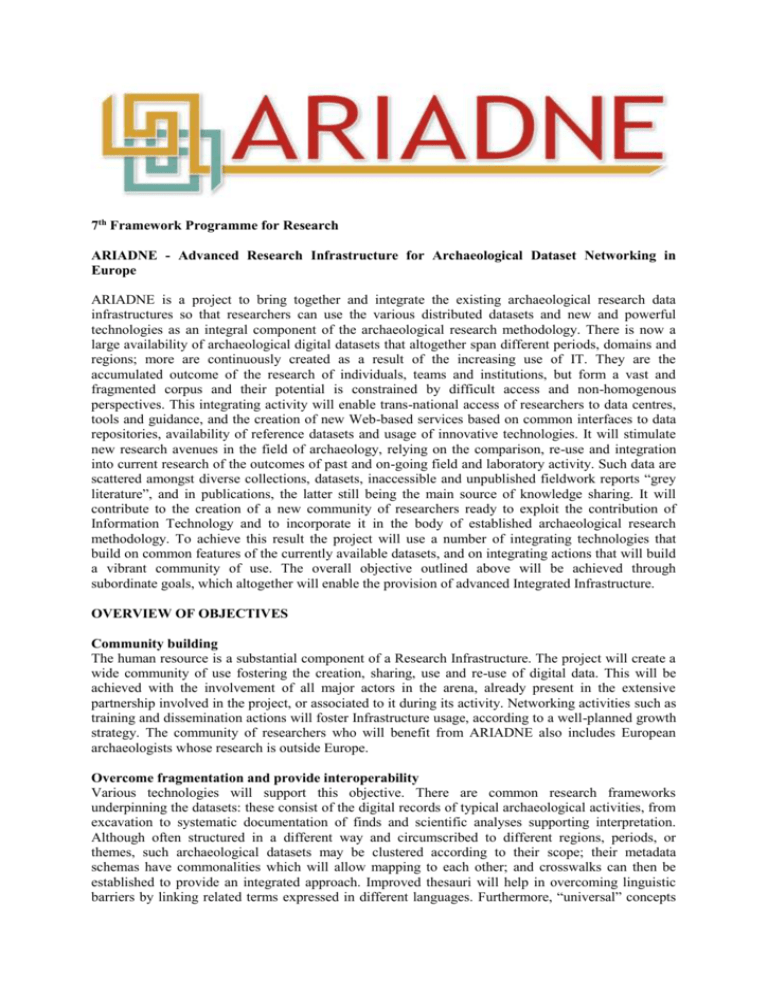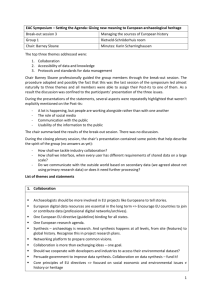7th Framework Programme for Research ARIADNE
advertisement

7th Framework Programme for Research ARIADNE - Advanced Research Infrastructure for Archaeological Dataset Networking in Europe ARIADNE is a project to bring together and integrate the existing archaeological research data infrastructures so that researchers can use the various distributed datasets and new and powerful technologies as an integral component of the archaeological research methodology. There is now a large availability of archaeological digital datasets that altogether span different periods, domains and regions; more are continuously created as a result of the increasing use of IT. They are the accumulated outcome of the research of individuals, teams and institutions, but form a vast and fragmented corpus and their potential is constrained by difficult access and non-homogenous perspectives. This integrating activity will enable trans-national access of researchers to data centres, tools and guidance, and the creation of new Web-based services based on common interfaces to data repositories, availability of reference datasets and usage of innovative technologies. It will stimulate new research avenues in the field of archaeology, relying on the comparison, re-use and integration into current research of the outcomes of past and on-going field and laboratory activity. Such data are scattered amongst diverse collections, datasets, inaccessible and unpublished fieldwork reports “grey literature”, and in publications, the latter still being the main source of knowledge sharing. It will contribute to the creation of a new community of researchers ready to exploit the contribution of Information Technology and to incorporate it in the body of established archaeological research methodology. To achieve this result the project will use a number of integrating technologies that build on common features of the currently available datasets, and on integrating actions that will build a vibrant community of use. The overall objective outlined above will be achieved through subordinate goals, which altogether will enable the provision of advanced Integrated Infrastructure. OVERVIEW OF OBJECTIVES Community building The human resource is a substantial component of a Research Infrastructure. The project will create a wide community of use fostering the creation, sharing, use and re-use of digital data. This will be achieved with the involvement of all major actors in the arena, already present in the extensive partnership involved in the project, or associated to it during its activity. Networking activities such as training and dissemination actions will foster Infrastructure usage, according to a well-planned growth strategy. The community of researchers who will benefit from ARIADNE also includes European archaeologists whose research is outside Europe. Overcome fragmentation and provide interoperability Various technologies will support this objective. There are common research frameworks underpinning the datasets: these consist of the digital records of typical archaeological activities, from excavation to systematic documentation of finds and scientific analyses supporting interpretation. Although often structured in a different way and circumscribed to different regions, periods, or themes, such archaeological datasets may be clustered according to their scope; their metadata schemas have commonalities which will allow mapping to each other; and crosswalks can then be established to provide an integrated approach. Improved thesauri will help in overcoming linguistic barriers by linking related terms expressed in different languages. Furthermore, “universal” concepts may be used as a background for integration and interoperability: among others, space is a unifying factor for archaeological data, and it allows GIS to be applied as a powerful integrating technology. Finally, the application of the Linked Data paradigm will create an innovative continuum, the Web of Archaeological Data, an eco-system with bridges to the overall Web of Data. Critical mass The project partners already have a critical mass of data and manage a number of effective but separate services which will be integrated within the proposed infrastructure. Thus the Integrated Infrastructure will be from its inception a usable and useful resource for the research community. It will attract further contributions, enlarging its scope and content, and hence its usefulness for the archaeological research community. Unified and homogeneous interfaces The project will set up a one-stop access point to archaeological datasets, enriched with a set of powerful innovative tools enabling, for example, the visualization and analysis of 2D and 3D documentation, or the creation of mash-ups built on the Infrastructure content and services. Long-term preservation Specific actions will address the long-term digital preservation of the data. Furthermore, incorporation of primary data including the so-called “grey literature” in the Integrated Infrastructure will preserve valuable information from obsolescence or loss. Development of innovative tools and services The existence of the Integrated Infrastructure will stimulate the creation of new datasets and services, based on the innovative tools, services and methodologies – for example, the extensions planned to enable multilingual searching and the implementation of an improved Conceptual Reference Model. The integration of existing datasets, the creation of new ones and the production of synthetic work will generate a continuous and structured stream of data for archaeological research. Creating a new generation of researchers The actions envisaged by the project will foster the development of a new generation of researchers skilled to exploit the advantages of research infrastructure for collaborative and complex, dataintensive research. Young researchers are addressed by all of the project training and dissemination actions, for example reserving for them a portion of the Transnational Access activities. Innovation for competitiveness and societal process This key driver of competitiveness and societal progress will be pursued through specific networking actions, aimed at involving key stakeholders and contributing to address major societal challenges, such as those created by the global changes induced by social, economic and environmental factors. It is anticipated that, for example, the project actions will have a substantial impact on related work concerning the preservation of tangible heritage through its sustainable exploitation, the communication of cultural values in an evolving society, and the definition of a multi-faceted European identity based on our shared past. Innovation in research will remain the focus of the project, through the definition of novel research paradigms made possible by the innovative technologies and methodologies developed in the Joint Research Activities program.







